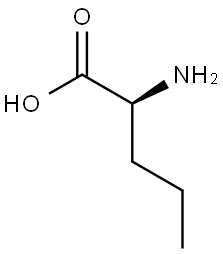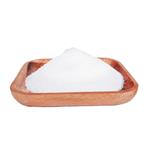Description
L-Norvaline, an amino acid nutritional supplements, is a nonessential amino acid that’s typically found in protein-rich foods, such as meat and eggs. And, it can also be made by the body from valine during normal metabolism. L-norvaline is frequently consumed by athletes as part of their workout supplement program. It is usually used for pre-workout drinks to boost energy and support post-workout recovery. During workouts, L-norvaline improves muscle tissue strength and endurance by providing massive amounts of oxygen and nutrients.
Chemical Properties
white to light yellow crystal powder
Uses
L-Norvaline is a protein amino acid used as a skin-conditioning and anti-static agent. It is also used in method for reducing misincorporation of non-canonical branched-chain Amino Acids into recombinant proteins.
Definition
ChEBI: L-Norvaline is a 2-aminopentanoic acid that has S-configuration. It has a role as a bacterial metabolite. It is a (R)-fenbuconazole and a 2-aminopentanoic acid. It is an enantiomer of a D-2-aminopentanoic acid. It is a tautomer of a L-2-aminopentanoic acid zwitterion.
benefits
Some benefits with taking L-norvaline:
L-Norvaline increases blood flow to working muscles, which can lead to greater muscle pumps during workouts, less soreness after workouts, and faster recovery times between workouts.
L-Norvaline, an amino acids supplement for men, may support nitric oxide production in healthy individuals, where nitric oxide plays an important role in many biological processes in the body including muscular contraction, blood circulation and blood flow throughout the body.
Biochem/physiol Actions
L-Norvaline enhances NO production from activated macrophages.
Side effects
Mild gastrointestinal symptoms such as stomach irritation, nausea, and vomiting may result from L-Norvaline supplementation.
Safety
Researchers from the University of Technology Sydney found taking the amino acid L-norvaline, even in small doses, could make cells unhealthy and eventually kill them.
However, in a study published in the US National Library of Medicine National Institutes of Health dated December 17, 2019, and entitled “Reports of L-Norvaline Toxicity in Humans May Be Greatly Overstated”, it was argued that the quantities of L-Norvaline used in the study claiming its toxicity was greatly above cytotoxic levels for all amino acids. Hence, it was concluded in the said study that as long as L-Norvaline is taken within recommended doses, it will not necessarily cause cytotoxic effects.
A typical dose of L-Norvaline is around 100mg-250mg per day.
Purification Methods
Crystallise norvaline from aqueous EtOH or water. [Greenstein & Winitz The Chemistry of the Amino Acids J. Wiley, Vol 3 pp 2390-2399 1961, Beilstein 4 III 1331-1333, 4 IV 128, 2629.]






